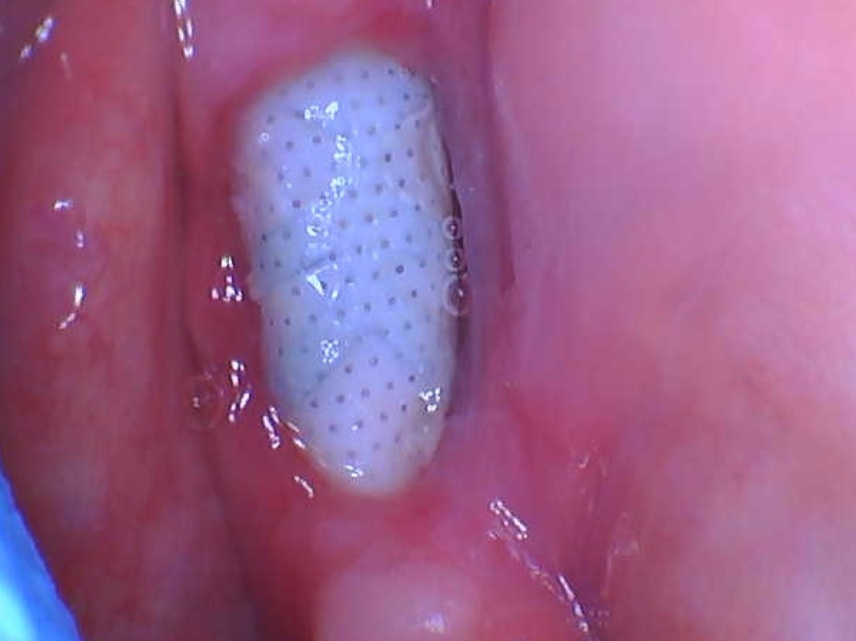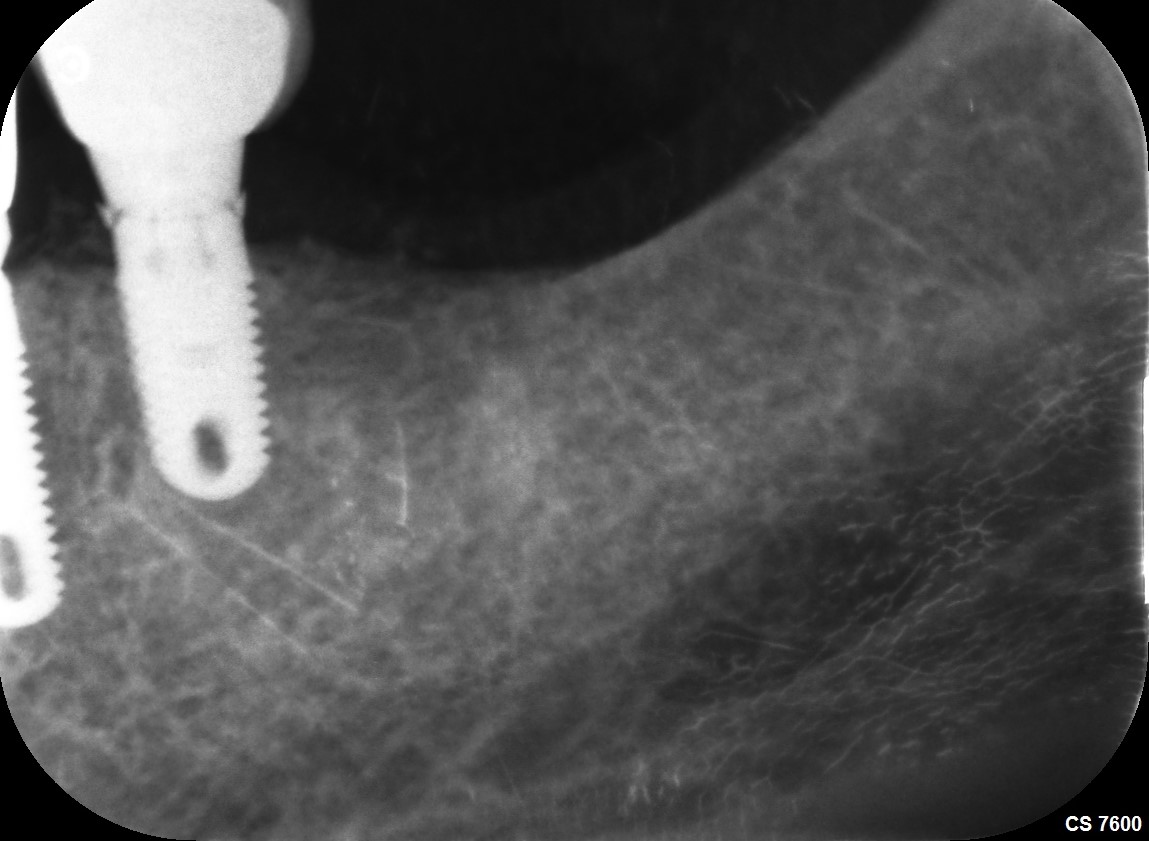Restorative Options for Unidentified Connection?
This patient presented to me having an implant done overseas 2 years ago in the lower right first molar site. There is a small area of mesial bone loss noted, but otherwise the implant looks well integrated. Clinically the ceramic crown (cemented on with no screw access hole noted occlusally) is loose. Can someone help me identify what implant this is and what is the restorative connection used here? There is no way to get any clinical records of what had been done previously, so I need any advise and help I can get before drilling into the crown. I’m hoping it is just the abutment screw that is loosened and I can tighten it with standard hex driver.

11 Comments on Restorative Options for Unidentified Connection?
New comments are currently closed for this post.
Carlos Boudet, DDS DICOI
4/8/2019
This day and age, communication with overseas practitioners is not a problem.
If you do not want to attempt to obtain it, you can create an access opening and unscrew the abutment-crown cemented restoration.
Once it is in your hand, inspect the screw and the connection, take pictures and send them to colleagues or suspected implant companies along with radiographs for identification. Make sure you have an assortment of the most common drivers to torque the screw back in place (removing it, almost anything will do).
Good luck!
Dr. Gerald Rudick
4/8/2019
I have had this problem in the past...… if you do not want to use Dr. Boudet's idea ( which is a good one ), you could put a metal matrix band around the tooth, as from the xray ...it would be easy to place...and then with a spring loaded crown and bridge remover, place the hook under the metal lever where the two ends meet, and gently release the spring and tap.....hopefully the dentist used a weak cement that would break away....the crown should come off, and you can drill an access hole for the future by drilling through the occlusal surface, should the abutment loosen again....good luck.
Larry J Meyer
4/8/2019
Be sure to treat the endo lesion on the 2nd bicuspid
Frank
4/8/2019
I would not try to remove the crown with any spring losded or pneumatic crown remover.
The crown is loose which means all the tapping load would be taken by the screw. You risk beaking the screw and damaging the threads.
Drill a hole in the crown, find the screw and unscrew it.
Maybe you can then re-torque like a screwed crown.
Knowing what country and what year the implant was put in will help you find what was in use. Go to the website ''whatisthisimplant.con'' or something like that.
Good luck.
Frank
4/8/2019
Once the crown removed why not try to improve the situation of the bone loss. Polish the threads, clean out the defect. An unscrewed implant crown will cause bone loss. Hopefully this will stop there.
Michael White CDT
4/8/2019
This implant is a Xive implant. It’s a DentsplySirona implant. It looks like either a 3.8 or 4.5 mm implant. It takes a 1.22 mm driver available from DentsplySirona Implants 800-531-3481
Dr Dale Gerke, BDS, BScDe
4/8/2019
The above suggestions are good.
Whatever method you decide on, you are going to need to drill through the occlusal surface of the crown anyway. So you might as well do this in the mouth. I recommend a diamond bur to go through the porcelain (probably a medium round) then once through the porcelain go to a fluted carbide bur (say a Jet 330) but do not touch the porcelain of it will instantly blunt the bur. It should only take about 10 minutes.
The radiograph shows the screw is virtually centrally placed in the mesial-distal direction, so it would be a good bet to suggest the screw will also be centrally placed in the buccal-lingual direction. Irrespective, it has to be done so just as easy to go for it and explore carefully.
Hopefully it is a loose screw which just needs tightening. The implant looks like an internal fixture but it does not matter what brand it is because you just need to find a driver that fits the screw head (many labs use generic screws and the head might be hex, star, redirectional, whatever). If you do not have a selection of drivers then it might be easier to ask a dentist who has been involved with implants for several decades to get it off. Most dentists with some years experience will have evolved a selection of different drivers. After that you could take over treatment and buy/borrow the appropriate driver or have a new screw made by an engineering firm. Another option could be to ask a bigger laboratory which constructs implant crowns if they have a selection of drivers. They might loan you some for a few hours. However lab drivers often have long/large handles which are hard to use in the mouth – but in this case you might be lucky. The laboratory will also be a good source of information about a new screw if required – or they should know an engineering firm who they use to make “one off” screws/abutments etc.
When the crown is off, you will be able to clean up the crown (I suspect the bone loss is due to excess cement being left after initial cementation) and treat the premolar more easily.
GARY COHEN
4/8/2019
I have a similar situation. Patient had implant and crown placed in Saudi and now lives in London. The crown is mobile. I have attempted to identify with some knowledgable clinicians. It was confirmed as Osstem however on contacting Osstem they were absolutely clear that it was not their brand.
I have asked patient to contact the clinician for details but she has not been successful.
Whilst I would truly like to help I am not prepared to touch this until I have the correct information as I do not wish to take ownership of someone else’s treatment to find I can’t easily resolve issue.
You may wish to think twice before getting involved without all the information.
If you drill access through crown and can’t locate screw access to abutment you may find you are suggesting a new crown. This is when the patient can question who should cover the costs. I would also be wary of the early signs of bone loss. This is possibly due to the mobile crown/ occlusal issues/ food trapping but you need to thoroughly explain this to patient before getting involved
mark
4/8/2019
My advice is...if you have never dealt with this situation before...don't jump in. You WILL break off the screw by tapping and you WILL strip the head by trying to unthread with the wrong hex wrench. Know what you are getting into BEFORE you do any cutting. "The website..."whatimplant is that .com" is where you start.
Karen
4/10/2019
Good website for identifying implants
https://whatimplantisthat.com/
Dr Dan
4/10/2019
It might be handy to have a healing cap available before you start in case the abutment needs to be off for any length of time.
















